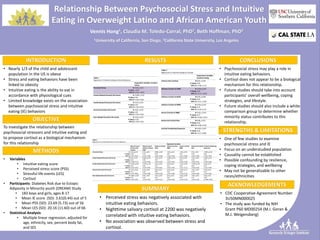
Hong_Vennis_Poster
- 1. Relationship Between Psychosocial Stress and Intuitive Eating in Overweight Latino and African American Youth Vennis Hong1, Claudia M. Toledo-Corral, PhD2, Beth Hoffman, PhD2 1University of California, San Diego, 2California State University, Los Angeles INTRODUCTION OBJECTIVE METHODS ACKNOWLEDGEMENTS STRENGTHS & LIMITATIONS CONCLUSIONS SUMMARY RESULTS • Nearly 1/3 of the child and adolescent population in the US is obese • Stress and eating behaviors have been linked to obesity • Intuitive eating is the ability to eat in accordance with physiological cues • Limited knowledge exists on the association between psychosocial stress and intuitive eating (IE) behaviors To investigate the relationship between psychosocial stressors and intuitive eating and to propose cortisol as a biological mechanism for this relationship • Variables • Intuitive eating score • Perceived stress score (PSS) • Stressful life events (LES) • Cortisol • Participants: Diabetes Risk due to Ectopic Adiposity in Minority youth (DREAM) Study • 183 boys and girls, ages 8-17 • Mean IE score (SD): 3.61(0.44) out of 5 • Mean PSS (SD): 23.69 (5.73) out of 56 • Mean LES (SD): 20.16 (11.60) out of 66 • Statistical Analysis • Multiple linear regression, adjusted for age, ethnicity, sex, percent body fat, and SES • Perceived stress was negatively associated with intuitive eating behaviors. • Nighttime salivary cortisol at 2200 was negatively correlated with intuitive eating behaviors. • No association was observed between stress and cortisol. • Psychosocial stress may play a role in intuitive eating behaviors. • Cortisol does not appear to be a biological mechanism for this relationship. • Future studies should take into account participants’ overall wellbeing, coping strategies, and lifestyle. • Future studies should also include a white comparison group to determine whether minority status contributes to this relationship. . • One of few studies to examine psychosocial stress and IE • Focus on an understudied population • Causality cannot be established • Possible confounding by resilience, coping strategies, and wellbeing • May not be generalizable to other races/ethnicities • CDC Cooperative Agreement Number 3U50MN000025 • The study was funded by NIH Grant P60 MD00254 (M.I. Goran & M.J. Weigensberg) Table 1 Regression of Intuitive Eating on Stress Measures Dependent Variable: Intuitive Eating Perceived Stress B P-value 95% CI -0.02 + 0.01 < 0.01 (-0.03, -0.01) School-Related Stressful Life Events B P-Value 95% CI -0.001 + 0.01 0.95 (-0.02, 0.02) Family-Related Stressful Life Events B P-value 95% CI -0.01 + 0.01 0.20 (-0.03, 0.01) Personal Stressful Life Events B P-value 95% CI -0.01 + 0.01 0.46 (-0.03, 0.02) Peer-Related Stressful Life Events B P-Value 95% CI -0.01 + 0.01 0.223 (-0.03, 0.01) Table 2 Regression of Intuitive Eating on Cortisol Dependent Variable: Intuitive Eating Urinary Free Cortisol B P-Value 95% CI 0.02 + 0.04 0.56 (-0.06, 0.11) Salivary Cortisol at 2200 B P-Value 95% CI -0.08 + 0.03 0.04 (-0.15, -0.01) Salivary Cortisol at 0530 B P-Value 95% CI 0.04 + 0.08 0.64 (-0.11, 0.18) Salivary Cortisol at 0600 B P-Value 95% CI -0.02 + 0.07 0.73 (-0.16, 0.11) Serum Cortisol at 0800 B P-Value 95% CI -0.01 + 0.01 0.27 (-0.031, 0.01) Nocturnal Cortisol Rise B P-Value 95% CI 0.08 + 0.07 0.26 (-0.06, 0.23) Cortisol Awakening Response B P-Value 95% CI -0.04 + 0.07 0.54 (-0.17, 0.09) Table 3 Regression of Cortisol Measures on Stress Measures Dependent Variables Natural Log of Urinary Free Cortisol Natural Log of Salivary Cortisol 2200 Salivary Cortisol 0530 Salivary Cortisol 0600 Serum Cortisol 0800 Nocturnal Cortisol Rise Cortisol Awakening Response Perceived Stress B P-Value 95% CI -0.03 + 0.02 0.107 (-0.07, 0.01) 0.01 + 0.01 0.34 (-0.01, 0.04) 0.004 + 0.01 0.56 (-0.01, 0.02) -0.01 + 0.01 0.87 (-0.02, 0.02) -0.05 + 0.05 0.35 (-0.15, 0.06) 0.01 + 0.01 0.56 (-0.01, 0.02) -0.002 + 0.01 0.84 (-0.02, 0.02) School-Related Stressful Life Events B P-Value 95% CI 0.02 + 0.50 0.64 (-0.08, 0.12) 0.004 + 0.02 0.83 (-0.03, 0.04) -0.01 + 0.01 0.55 (-0.02, 0.01) -0.003 + 0.01 0.73 (-0.02, 0.02) 0.07 + 0.06 0.26 (-0.05, 0.20) -0.01 + 0.01 0.49 (-0.03, 0.01) 0.004 + 0.01 0.73 (-0.02, 0.03) Family-Related Stressful Life Events B P-Value 95% CI -0.002 + 0.02 0.95 (-0.05, 0.05) -0.001 + 0.02 0.95 (-0.04, 0.04) -0.01 + 0.01 0.70 (-0.03 0.02) 0.02 + 0.01 0.21 (-0.01, 0.04) -0.05 + 0.08 0.55 (-0.21, 0.11) -0.003 + 0.01 0.83 (-0.03, 0.02) 0.02 + 0.02 0.29 (-0.01, 0.04) Personal Stressful Life Events B P-Value 95% CI -0.01 + 0.03 0.71 (-0.07, 0.05) 0.03 + 0.03 0.34 (-0.03, 0.08) 0.00 + 0.02 0.99 (-0.03, 0.03) 0.02 + 0.02 0.16 (-0.01, 0.06) -0.06 + 0.10 0.56 (-0.25, 0.14) -0.01 + 0.02 0.70 (-0.04, 0.02) 0.02 + 0.02 0.22 (-0.01, 0.06) Peer-Related Stressful Life Events B P-Value 95% CI -0.002 + 0.03 0.93 (-0.06, 0.05) 0.01 + 0.02 0.64 (-0.03, 0.05) -0.02 + 0.01 0.23 (-0.04, 0.01) 0.01 + 0.01 0.45 (-0.02, 0.04) -0.02 + 0.08 0.78 (-0.19, 0.14) -0.02 + 0.01 0.21 (-0.04, 0.01) 0.03 + 0.01 0.08 (-0.003, 0.05)